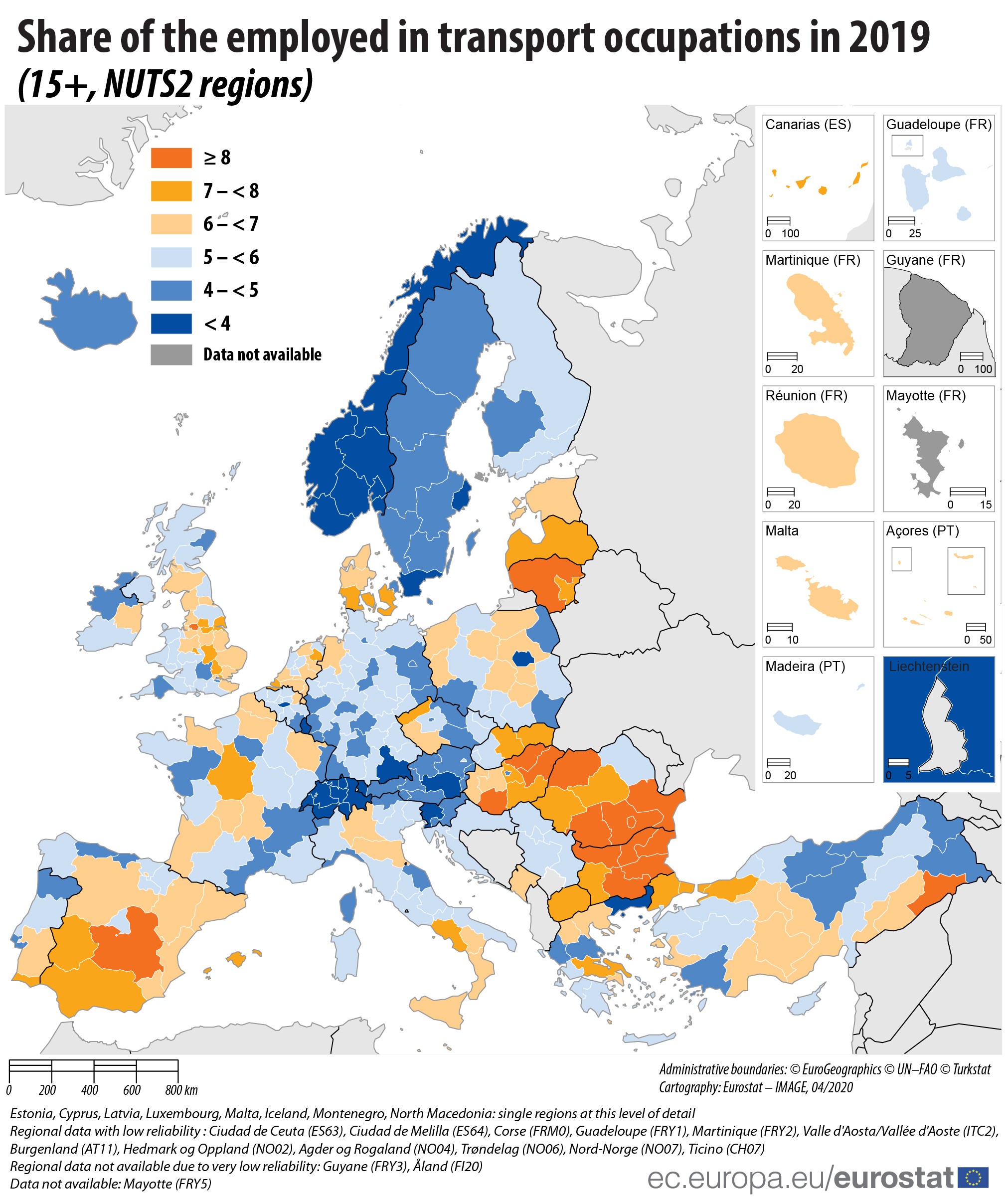In 2019, 11.6 million people aged over 15 were employed in transport occupations in the European Union (EU), representing 6% of all people employed and 3% of the total population.
These transport jobs include heavy truck and bus drivers (35% of people employed in transport occupations), transport and storage labourers (23%), car, van and motorcycle drivers (19%), messengers, package deliverers, luggage porters and other elementary workers (12%), refuse workers (5%), locomotive engine drivers and related workers (3%) and travel attendants, conductors and guides (3%).
Their role is crucial for providing an effective response and for keeping essential transport of essential goods, such as medical supplies, going during this period of corona crisis.
The vast majority of the transport workers were men (84%). Over one third each of people employed in transport occupations in the EU were aged 35-49 years old (37%) or aged 50 years old or over (36%). On the other hand, only one quarter of them were aged less than 35 (27%).
In two-thirds (18 of 27) of the EU Member States, the largest share of transport workers were aged 35-49 years old, with the highest share reported in Greece (46%), followed by Romania (45%), Czechia (44%), Croatia and Spain (both 43%).
In seven EU Member States, people aged over 50 years old accounted for the largest share of transport workers, with the highest share reported in Estonia (56%), followed by Latvia (54%), Lithuania (48%) and Germany (46%). In only two EU Member States did transport workers aged 15-34 represent the largest share: the Netherlands (54%) and Finland (39%).
Highest shares of transport workers in Bulgaria
Among the EU Member States, Bulgaria recorded the highest share of transport workers amongst all those employed (10% of the employed), followed by Lithuania (9%), Romania and Latvia (both 8%). In contrast, the lowest shares were recorded in Sweden, Luxembourg and Slovenia, where transport workers represented 4% of the employed.
Relative to population size, similarly Bulgaria and Lithuania recorded the highest shares (both 5% of the total population), followed by eight EU Member States with 4% each: Romania, Latvia, Estonia, the Netherlands, Hungary, Slovakia, Malta and Denmark. At the other end of the scale, the lowest shares were recorded in three EU Member States: Slovenia, Luxembourg and Sweden, where transport workers represented only around 2% of the total population.
Spotlight on transport workers in EU regions
The highest shares of transport workers were generally recorded in south-eastern regions of the EU:
- five Bulgarian regions: Severozapaden (14%), Severen tsentralen (11%), Yuzhen tsentralen and Severoiztochen (both 10%) and Yugoiztochen (9%),
- five Romanian regions: Sud-Muntenia (11%), Nord-Vest (9%), Sud-Est, Bucuresti-Ilfov and Sud-Vest Oltenia (all 8%), as well as
- three Hungarian regions: Észak-Magyarország (10%), Dél-Dunántúl and Észak-Alföld (both 8%).
Nevertheless, Castilla-La Mancha (8%) in Spain and Vidurio ir vakarų Lietuvos regionas (9%) in Lithuania also registered a high share of transport workers.
Notes:
- Transport occupations in this article, as defined by the ISCO-08 classification, include: 511 - Travel attendants, conductors and guides, 831 - Locomotive engine drivers and related workers, 832 - Car, van and motorcycle drivers, 833 - Heavy truck and bus drivers, 933 - Transport and storage labourers, 961 - Refuse workers and 962 - Messengers, package deliverers, luggage porters and other elementary workers.
- Regional data for Estonia, Cyprus, Latvia, Luxembourg, Malta: single regions at this level of detail
- Regional data with low reliability: Ciudad de Ceuta (ES63), Ciudad de Melilla (ES64), Corse (FRM0), Guadeloupe (FRY1), Martinique (FRY2), Valle d'Aosta/Vallée d'Aoste (ITC2), Burgenland (AT11), Hedmark og Oppland (NO02), Agder og Rogaland (NO04), Trøndelag (NO06), Nord-Norge (NO07), Ticino (CH07)
- Regional data not available due to very low reliability: Guyane (FRY3), Åland (FI20)
- Data not available: Mayotte (FRY5)
- The European Union (EU) includes 27 EU Member States. The United Kingdom left the European Union on 31 January 2020. Further information is published here.
Source data:
To contact us, please visit our User Support page.
For press queries, please contact our Media Support.



